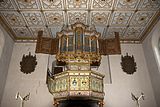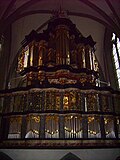Marten de Mare
Marten de Mare , also Martinus, Merten, Meerten , (* around 1540 probably in Groningen ; † 1612 in Bremen ) was a late renaissance organ builder in Groningen and Bremen. About a dozen activities (new constructions, extensions and repairs) on own or third-party organs are documented, but only individual stops or parts of organs from de Mare survive today, including two splendid brochures in Stellichte (1610) and St. Ansgarii in Bremen (1611) .
Life
The father Andreas de Mare was also an organ builder and moved - possibly because of his Protestant faith - from Ghent to Groningen, where he acquired the so-called minor citizenship for himself and his sons Christoffer and Marten in 1560 . Marten de Mare was probably born in Groningen and named after the patron saint of the Martinikerk in Groningen , where his father built a major organ extension in 1542. After initially working in his father's workshop, Marten first emerged as an independent organ builder in 1578 when he was rebuilding the organ in the Great Church of Emden , where he worked until 1594. The time in Emden was interrupted by a few years of activity in Verden (Aller) from 1583.
In the course of the Emden Revolution in 1595, he moved with his family to Bremen, where he took the oath of citizenship in the same year and acquired Bremen citizenship together with his wife and two daughters. Naturalization took place on June 27, 1595. A repair of the positive of St. Stephani is attested as early as 1586 ; further organ repairs and new buildings in other Bremen churches followed. Edo Evers and Johann Busse probably learned organ building from de Mare. From 1599 to 1601 he settled in Paderborn and built three new buildings in southern Westphalia.
Marten de Mare was married; he and his wife Take de Mare had several children. In addition to the two daughters Franke and Eime, the son Martini de Mare is proven. Marten de Mare died in Bremen in 1612.
plant
Marten de Mare was in the tradition of the organ builder Hendrik Niehoff . His works are characterized by splendidly designed brochures that are characterized by the late Renaissance. The hinged wing doors also contribute to the representative appearance. The preserved cases in Stellichte and St. Ansgari in Bremen are "among the most beautiful creations of the Renaissance in Northern Germany". Two-manual works have a return positive . It is possible that the organ case in the Stellichter St. Georg Christophorus Jodokus Church goes back to Andreas de Mare, whose organ for the East Frisian monastery Thedinga was demolished in 1609 by son Marten in the course of the dissolution of the monastery.
The plenum , which is based on principal registers, is fundamental to the disposition , supplemented by flute and reed parts, which reflect the instruments of the Renaissance. According to research by Wilfried Michel, the original double doors of the organ in Oelinghausen Monastery have been redesigned into the panel paintings on the organ back wall.
List of works
Italics indicate that the organ has not been preserved or only the historical case has been preserved. In the fifth column, the Roman number indicates the number of manuals and a capital "P" indicates an independent pedal . The Arabic number indicates the number of sounding registers . The last column provides information on the state of preservation or special features.
| year | place | church | image | Manuals | register | Remarks |
|---|---|---|---|---|---|---|
| 1578-1582 | Emden | Big church | II / P | 9 (?) | Expansion of the old one-manual organ, which was installed from the Blauhaus monastery in 1565–68 (at least 1/4; size FGA-g 2 a 2 ) by Andreas and Marten de Mare. From 1585–94 Marten carried out repairs and the annual obligation alone. In 1710 it is said to have 13 registers. Nothing has survived from this instrument. | |
| 1597 | Jever | City Church | New building; The organ is delivered from Bremen with the traditional manual range of the Renaissance (FGA-g 2 a 2 ). This instrument was eliminated due to later new constructions. | |||
| before 1600 | Oldenburg | Lamberti Church | I. | 9 | Repair of slegel ; not received | |
| 1599 | Oelinghausen Monastery | Monastery church | New building using older registers from 1586; later extensions; some registers preserved → organ | |||
| 1600/01 | Altenhundem | Ev. church | New building, not preserved | |||
| 1600/01 | Schnellenberg Castle | chapel | New building, not preserved | |||
| 1603 | Bremen | St. Martini | I. | New construction or enlargement conversion. It is not clear whether Christian Bockelmann replaced the organ with a new one in 1616–19 or only remodeled it. The valuable prospectus was preserved through outsourcing during the Second World War . → Organ in St. Martini Bremen | ||
| 1608-1609 | Empty | Big church in Leer |

|
I. | 10 | New building using old registers from the organ of the abolished Thedinga monastery , which his father had built in 1590 at the latest after Count Enno III. Had given the instrument to the church in Leer in 1609. Extensions by Albertus Antonius Hinsz (1763/1766), Wilhelm Caspar Joseph Höffgen and Brond de Grave Winter (1846–1850) and Paul Ott (1953–55), whereby the basic inventory of de Mare was retained. In 2006-08 the old pipe inventory was systematically recorded based on the inscriptions from the Organeum ( Weener ). A comprehensive renovation or reconstruction is still pending. → Organ of the Great Church (Leer) |
| 1610 | Bremen | St. Stephani | Repair; not received | |||
| 1610 | Stellicht | St. Georg Christophorus Jodokus Church |

|
II / P | 12 | It is possible that de Mare brought the precious case of the Thedinga monastery organ with the richly decorated prospectus to Stellichte and recreated the internal piping, which was later replaced. In this context, de Mare has converted the prospectus pipes (formerly Principal 4 ') into a Quintadena 8' by soldering on lids. In 1985 Jürgen Ahrend reconstructed an interior work in the sense of the original condition. The splendid prospectus has been preserved and blends in with the renaissance interior of the manor chapel. |
| 1611 | Bremen | St. Ansgarii | II | New organ with Rückpositiv , which was later expanded to include pedal towers. Most of the splendid prospectus has been preserved, as it was saved by relocating it while the church and organ were destroyed in the Second World War. → Organ from St. Ansgarii Bremen |
literature
- Jürgen Ahrend , Winfried Dahlke : Documentation of the organ of the Evangelical Reformed Church in Leer . Print-on-demand (presumably Stade 2008 without location and year information).
- Walter Kaufmann : The organs of East Frisia. Organ topography (= treatises and lectures on the history of East Frisia . Volume 48 ). East Frisian Landscape, Aurich 1968.
- Ibo Ortgies : The practice of organ tuning in northern Germany in the 17th and 18th centuries and its relationship to contemporary music practice . Göteborgs universitet, Göteborg 2004 ( gbv.de [PDF; 5.4 MB ] rev. 2007).
- Uwe Pape , Winfried Topp: organs and organ builders in Bremen . 3. Edition. Pape Verlag, Berlin 2003, ISBN 3-921140-64-1 .
- Fritz Piersig : The organs of the Bremen city churches in the 17th and 18th centuries . In: Bremisches Jahrbuch . tape 35 , 1935, pp. 379-425 ( brema.suub.uni-bremen.de ).
- Harald Polenz, Wilfried Michel: The organs of the monastery church Oelinghausen . In: Magdalena Padberg (Ed.): Oelinghausen Monastery and the historical organs . East Frisian Landscape, Iserlohn 1989, ISBN 3-922885-44-6 , p. 146-200 .
- Auke H. Vlagsma: Andreas en Marten de Mare Orgelmakers van de Renaissance - Deel 1: Inleiding en works van Andreas de Mare . In: Het Orgel . tape 109 , 2013, p. 36-41 .
- Auke H. Vlagsma: Andreas en Marten de Mare. Orgelmakers uit de Renaissance. Deel 2: Works by Andreas en Marten de Mare . In: Het Orgel . tape 110 , 2014, p. 18-29 .
- Harald Vogel , Günter Lade, Nicola Borger-Keweloh: Organs in Lower Saxony . Hauschild Verlag, Bremen 1997, ISBN 3-931785-50-5 .
- Harald Vogel, Reinhard Ruge, Robert Noah, Martin Stromann: Organ landscape Ostfriesland . 2nd Edition. Soltau-Kurier-Norden, Norden 1997, ISBN 3-928327-19-4 .
- Maarten Albert Vente : The Brabant Organ. On the history of organ art in Belgium and Holland in the Gothic and Renaissance ages . HJ Paris, Amsterdam 1963.
Individual evidence
- ↑ a b Pape, Topp: Organs and Organ Builders in Bremen. 2003, p. 403.
- ^ Kaufmann: Organs in Ostfriesland. 1968, pp. 35, 100-101.
- ↑ a b c Bürgerbuch der Altstadt 1586–1609 June 19. State Archives Bremen , Bremen, signature: 2-P.8.A.19.a.2.a, p. 68
- ^ Pape, Topp: Organs and Organ Builders in Bremen. 2003, p. 404.
- ^ Citizens' Book [1642]. Bremer Staatsarchiv, Bremen, signature: P.8.A.19.a.3. (Excerpt from the entry: "Mare, de, Dirich. As des blessed Martini de Mare, the son of a former citizen, he swore his oath on January 31, 1642 after coming of age and was thereby naturalized [...]." )
- ^ Kaufmann: Organs in Ostfriesland. 1968, p. 35.
- ↑ Ahrend, Dahlke: Documentation of the organ of the Evangelical Reformed Church in Leer. 2008, pp. 5f., 12, 240-248.
- ↑ Sauerland. Journal of the Sauerland Heimatbund . No. 1, 1988, p. 10, accessed on January 9, 2019 (PDF file; 2.92 MB).
- ^ Fritz Piersig: The organs of the Bremen city churches in the 17th and 18th centuries. In: Bremisches Jahrbuch . No. 35, 1935, pp. 389-391 ( brema.suub.uni-bremen.de ), viewed January 23, 2011.
- ^ Organ in Stellichte , accessed on January 9, 2019.
| personal data | |
|---|---|
| SURNAME | Mare, Marten de |
| ALTERNATIVE NAMES | Mare, Martinus de; Mare, Merten de; Mare, Meerten de |
| BRIEF DESCRIPTION | Organ builder |
| DATE OF BIRTH | around 1540 |
| PLACE OF BIRTH | unsure: Groningen |
| DATE OF DEATH | 1612 |
| Place of death | Bremen |


